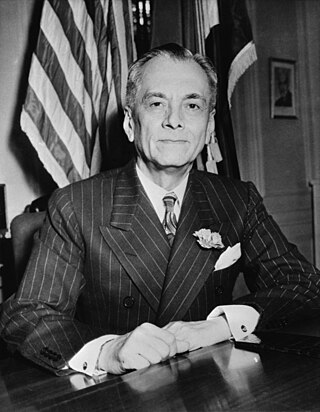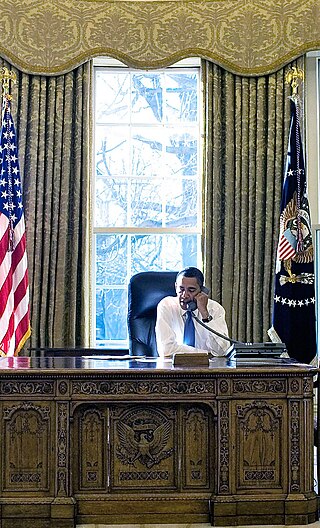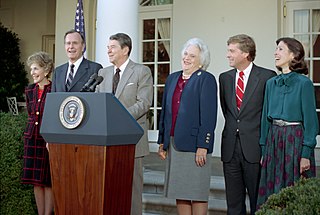
The 1936 United States presidential election was the 38th quadrennial presidential election, held on Tuesday, November 3, 1936. In the midst of the Great Depression, incumbent Democratic President Franklin D. Roosevelt defeated Republican Governor Alf Landon of Kansas in a landslide. Roosevelt won the highest share of the popular vote (60.8%) and the electoral vote since the largely uncontested 1820 election. The sweeping victory consolidated the New Deal Coalition in control of the Fifth Party System.

Huey Pierce Long Jr., nicknamed "The Kingfish", was an American politician who served as the 40th governor of Louisiana from 1928 to 1932 and as a United States senator from 1932 until his assassination in 1935. He was a left-wing populist member of the Democratic Party and rose to national prominence during the Great Depression for his vocal criticism of President Franklin D. Roosevelt and his New Deal, which Long deemed insufficiently radical. As the political leader of Louisiana, he commanded wide networks of supporters and often took forceful action. A controversial figure, Long is celebrated as a populist champion of the poor or, conversely, denounced as a fascistic demagogue.

Manuel Luis Quezon y Molina, also known by his initials MLQ, was a Filipino lawyer, statesman, soldier, and politician who was president of the Commonwealth of the Philippines from 1935 until his death in 1944. He was the first Filipino to head a government of the entire Philippines and is considered the second president of the Philippines after Emilio Aguinaldo (1899–1901), whom Quezon defeated in the 1935 presidential election.

The United States presidential line of succession is the order in which the vice president of the United States and other officers of the United States federal government assume the powers and duties of the U.S. presidency upon an elected president's death, resignation, removal from office, or incapacity.

It Can't Happen Here is a 1935 dystopian political novel by American author Sinclair Lewis. Set in the fictionalized version of 1930s United States, it follows an American politician, Berzelius "Buzz" Windrip, who quickly rises to power to become the country's first outright dictator and Doremus Jessup, a newspaper editor who sees Windrip's fascist policies for what they are ahead of time and who becomes Windrip's most ardent critic. The novel was adapted into a play by Lewis and John C. Moffitt in 1936.
This section of the timeline of United States history concerns events from 1930 to 1949.
"Read my lips: no new taxes" is a phrase spoken by American presidential candidate George H. W. Bush at the 1988 Republican National Convention as he accepted the nomination on August 18. Written by speechwriter Peggy Noonan, the line was the most prominent sound bite from the speech. The pledge not to tax the American people further had been a consistent part of Bush's 1988 election platform, and its prominent inclusion in his speech cemented it in the public consciousness.

Gerald Lyman Kenneth Smith was an American clergyman, politician and organizer known for his populist and far-right demagoguery. A leader of the populist Share Our Wealth movement during the Great Depression, afterward he became known for far-right causes including the Christian Nationalist Crusade, which he founded in 1942. He founded the America First Party in 1943 and was its 1944 presidential candidate, winning fewer than 1,800 votes. He was a preeminent antisemite and a white supremacist.

DC 9/11: Time of Crisis is a 2003 docudrama television movie which re-enacts the events of the September 11 attacks in 2001 as seen from the point of view of the President of the United States and his staff. It was directed by Brian Trenchard-Smith and starred Timothy Bottoms as President George W. Bush.

The first 100 days of Barack Obama's presidency began on January 20, 2009, the day Barack Obama was inaugurated as the 44th president of the United States. The first 100 days of a presidential term took on symbolic significance during Franklin D. Roosevelt's first term in office, and the period is considered a benchmark to measure the early success of a president. The 100th day of his presidency ended at noon on April 30, 2009. Obama stated that he should not be judged just by his first hundred days: "The first hundred days is going to be important, but it’s probably going to be the first thousand days that makes the difference." Obama began to formally create his presidential footprint during his first 100 days. Obama quickly began attempting to foster support for his economic stimulus package, American Recovery and Reinvestment Act of 2009. The bill passed in the House on January 28, 2009, by a 244–188 vote, and it passed in the Senate on February 10 by a 61–37 margin.

At 2:15 a.m. Eastern Time on September 20, 1881, Chester A. Arthur was inaugurated the 21st president of the United States. The inauguration marked the commencement of Chester A. Arthur's only term as president. The presidential oath of office was administered by New York Supreme Court Justice John R. Brady at Arthur's private residence in New York City. Two days later, Arthur took part in a second inauguration in Washington, D.C., with the oath administered by Morrison Waite, the Chief Justice of the United States. Arthur became president following the death of his predecessor James A. Garfield, who had been assassinated by a troubled office seeker, Charles J. Guiteau.

The 1936 United States presidential election in North Dakota took place on November 3, 1936, as part of the 1936 United States presidential election. Voters chose four representatives, or electors to the Electoral College, who voted for president and vice president.

The 1936 United States presidential election in Louisiana took place on November 3, 1936, as part of the 1936 United States presidential election. Louisiana voters chose ten representatives, or electors, to the Electoral College, who voted for president and vice president.

The presidential transition of Bill Clinton began when he won the United States presidential election on November 3, 1992, and became the president-elect. Clinton was formally elected by the Electoral College on December 14, 1992. The results were certified by a joint session of Congress on January 8, 1993, and the transition ended when Clinton was inaugurated at noon EST on January 20, 1993.

The presidential transition of George H. W. Bush began when then-Vice President Bush won the United States 1988 United States presidential election, becoming the president-elect, and ended when Bush was inaugurated at noon EST on January 20, 1989.

The presidential transition of Jimmy Carter began when he won the 1976 United States presidential election, becoming the president-elect, and ended when Carter was inaugurated at noon EST on January 20, 1977.

The presidential transition of Richard Nixon began when he won the United States 1968 United States presidential election, becoming the president-elect, and ended when Nixon was inaugurated at noon EST on January 20, 1969. Nixon had become president-elect once the election results became clear on November 6, 1968, the day after the election. This was the first presidential transition to take place following the passage of the Presidential Transition Act of 1963.

The presidential transition of John F. Kennedy began when he won the 1960 United States presidential election, becoming the president-elect of the United States, and ended when Kennedy was inaugurated at noon EST on January 20, 1961.

The presidential transition of Dwight D. Eisenhower began when he won the United States 1952 United States presidential election, becoming the president-elect, and ended when Eisenhower was inaugurated at noon EST on January 20, 1953.


















